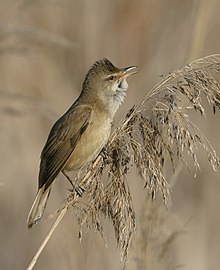Reed warbler
| Acrocephalus | |
|---|---|
 |
|
| Great reed warbler, Acrocephalus arundinaceus | |
| Scientific classification | |
| Kingdom: | Animalia |
| Phylum: | Chordata |
| Class: | Aves |
| Order: | Passeriformes |
| Family: | Acrocephalidae |
| Genus: |
Acrocephalus J. A. Naumann and J. F. Naumann, 1811 |
| Species | |
|
About 35, see text. |
|
About 35, see text.
The Acrocephalus warblers are small, insectivorous passerine birds belonging to the genus Acrocephalus. Formerly in the paraphyletic Old World warbler assemblage, they are now separated as the namesake of the marsh and tree warbler family Acrocephalidae. They are sometimes called marsh warblers or reed warblers, but this invites confusion with marsh warbler and reed warbler proper, especially in North America, where it is common to use lower case for bird species.
These are rather drab brownish warblers usually associated with marshes or other wetlands. Some are streaked, others plain. Many species are migratory.
Many species have a flat head profile, which gives rise to the group's scientific name.
Species breeding in temperate regions are strongly migratory.
The most enigmatic species of the genus, the large-billed reed warbler (A. orinus), was rediscovered in Thailand in March, 2006; it was found also in a remote corner of Afghanistan in the summer of 2009. Prior to these recent sightings, it had been found only once before, in 1867.
The genus name Acrocephalus is from Ancient Greek akros, "highest", and kephale, "head". It is possible that Naumann and Naumann thought akros meant "sharp-pointed".
Fragmentary fossil remains from the Late Miocene (about 11 mya) of Rudabánya (NE Hungary) show some apomorphies typical of this genus. Given its rather early age (most Passerida genera are not known until the Pliocene), it is not too certain that it is correctly placed here, but it is highly likely to belong to the Acrocephalidae at the least.
...
Wikipedia
